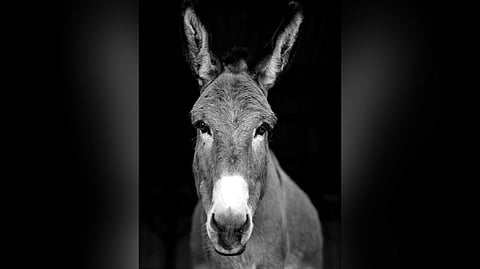

The donkey is a key, if increasingly marginalized, character in human history. Once venerated, the animal has been an object of ridicule for so long that the word “asinine” — derived from the Latin asinus, meaning “like an ass or a donkey” — means “stupid.” Donkeys and donkey work are essential to the livelihoods of people in developing countries, but elsewhere donkeys have all but disappeared.
“I guess that we simply forgot the importance of this animal, probably being blown away by the impact of its close cousin, the horse,” said Ludovic Orlando, director of the Center for Anthropobiology and Genomics of Toulouse in France. “In Europe, the horse provided fast mobility and helped grow crops and make war. I am not sure we can claim that the impact of the donkey was as large.” Compared to horses and dogs, donkeys have received relatively little attention from archaeologists, much less geneticists.
Nonetheless, despite this being the Year of the Rabbit according to the Chinese zodiac, it might just be the Year of the Donkey. The Oscar-nominated film “EO” features as its hero a soulful, barbarously misused donkey. And donkeys star in a major new genetic study published in the journal Science; Peter Mitchell, an archaeologist at Oxford who was not involved in the project, called it “the most comprehensive study of donkey genomics yet.”
Dr. Orlando, who has spent years mapping the domestication history of horses, is an author of the paper, which he hopes will jump-start research on the humble donkey and restore some of its dignity. He and researchers from 37 laboratories around the world analyzed the genomes of 207 modern donkeys, living in 31 countries. They also sequenced DNA from the skeletons of 31 early donkeys, some of which date as far back as 4,500 years.
Scholars had previously identified three potential centers of domestication, in the Near East, northeast Africa (including Egypt) and the Arabian Peninsula. But Dr. Orlando’s team concluded that donkeys — humanity’s first land-based transport — were domesticated only once, around 5,000 B.C., when herders in the Horn of Africa and present-day Kenya began to tame wild asses. That date is about 400 years before the earliest archaeological evidence of tamed donkeys from El Omari, near Cairo, and nearly three millenniums before horses were first harnessed.
The period coincided with one where the Sahara grew larger and more arid. Donkeys are especially resistant to drought and tolerant to water deprivation, which has led Dr. Orlando to speculate that they became an indispensable conveyance for herders and their wares. “Finding an auxiliary for transportation in those increasingly difficult conditions probably triggered the domestication process,” he said.
From that point of origin in northeastern Africa, the team then reconstructed the evolutionary tree of donkeys and traced their dispersal routes across the rest of the continent. Donkeys were traded northwest into today’s Sudan and onward into Egypt, trotting out of Africa around 5,000 years ago, and splitting off to Asia and Europe some 500 years later.
Visit news.dtnext.in to explore our interactive epaper!
Download the DT Next app for more exciting features!
Click here for iOS
Click here for Android